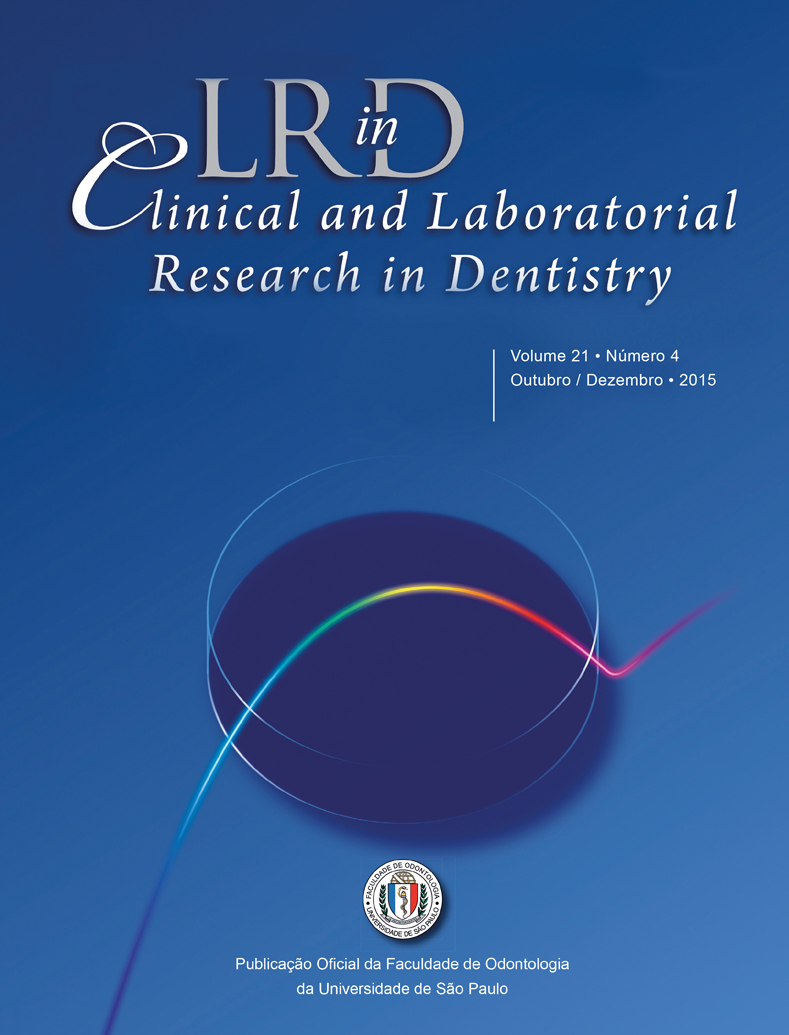The influence of film type and processing method on radiographic density for occlusal caries diagnosis
DOI:
https://doi.org/10.11606/issn.2357-8041.clrd.2015.123684Palavras-chave:
Diagnóstico radiográfico, cárie dental, radiografia dental digital, odontologia em saúde coletivaResumo
Objectives: This study aimed to investigate the influence of the radiographic processing method on the radiographic density of two types of film. Radiographs from non-cavitated occlusal caries lesions obtained in a previous study were used. Methods: We analyzed 28 films from 12 patients that were obtained with the same X-ray device. Seven Ektaspeed (Kodak Eastman Kodak Co, Rochester, NY, USA) and seven Ultraspeed (Kodak Eastman Kodak Co) films were manually processed, while seven Ektaspeed and seven Ultraspeed films were automatically processed. The angle of incidence of the X-ray beam and the distances between the apparatus, the tooth and the film were standardized. Therefore, the study comprised four groups: GE1: Ektaspeed manually processed; GE2: Ektaspeed automatically processed; GU1: Ultraspeed manually processed; and GU2: Ultraspeed automatically processed. The images were digitized (G40450 Scan Jet C/T, Hewlett-Packard) and analyzed using Digora for Windows 2.7 (Soredex Medical Systems) to obtain the average radiographic density, and the data were analyzed using the Student’s t test for paired data (Bioestat 5.3). Results: Only the Ektaspeed film showed statistically significant differences between radiographic densities with different processing methods (p = 0.0037). Conclusions: The Ektaspeed film automatic pocessed is better suited for the early diagnosis of caries lesions.
Downloads
Downloads
Publicado
Edição
Seção
Licença
Solicita-se aos autores enviar, junto com a carta aos Editores, um termo de responsabilidade. Dessa forma, os trabalhos submetidos à apreciação para publicação deverão ser acompanhados de documento de transferência de direitos autorais, contendo a assinatura de cada um dos autores, cujo modelo está a seguir apresentado:
Eu/Nós, _________________________, autor(es) do trabalho intitulado _______________, submetido agora à apreciação da Clinical and Laboratorial Research in Dentistry, concordo(amos) que os autores retém o direitos autorais e garantem a revista o direito da primeira publicação, sendo o trabalho simultaneamente autorizado sob a Creative Commons Attribution License, que permite a outros compartilhar o artigo com reconhecimento da autoria do trabalho e publicação inicial nesta Revista. Aos autores será possibilitada a distribuição em separado da versão publicada do artigo, arranjos contratuais adicionais para a distribuição não-exclusiva da versão publicada (por exemplo, publicá-la em um repositório institucional ou publicação em livro), com o reconhecimento de sua publicação inicial nesta revista. Aos autores será permitido e encorajado publicar seu trabalho on-line (por exemplo, em repositórios institucionais ou em seu site) antes e durante o processo de envio, pois pode levar a intercâmbios produtivos, bem como a maior citação do trabalho publicado. (Veja The Effect of Open Access).
Data: ____/____/____Assinatura(s): _______________


